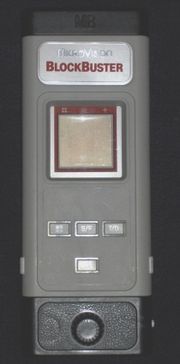| Microvision | |
|---|---|

| |
| Basic Information | |
Type(s) |
Handheld Console |
Generation |
Second |
| Milton Bradley Company | |
| Technical Information | |
Supported Media |
Cartridge |
| 1979 | |
| 1979 | |
| Awards | Covers | Credits | Gallery | Help Patches | Reviews | Screenshots | Videos | |
The Microvision was a handheld video game console released by the Milton Bradley Company in 1979. The Microvision was designed by Jay Smith, the engineer who would later design the Vectrex gaming console. The Microvision's combination of portability and a cartridge-based system led to moderate success, with Smith Engineering grossing $8 million in the first year of the system's release. However, very few cartridges, a small screen, and a lack of support from established home video game companies led to its demise in 1981.
Production[ | ]
The first Microvision cartridges were made with both Intel 8021 and Texas Instruments TMS1100 processors. Due to purchasing issues, Milton Bradley switched to using TMS1100 processors exclusively. The TMS1100 was a more primitive device, but offered more memory and lower power consumption than the 8021. First-revision Microvisions needed two batteries due to the 8021's higher power consumption, but later units (designed for the TMS1100) only had one active battery holder. Due to the high cost of changing production molds, Milton Bradley did not eliminate the second battery compartment, but instead removed its terminals and called it the spare battery holder.
Problems[ | ]
Microvision units and cartridges are now very rare. Those that are still in existence are susceptible to three main problems: "screen rot," ESD damage, and keypad destruction.
Screen rot[ | ]
The manufacturing process used to create the Microvision's LCD was primitive by today's standards. Poor sealing and impurities introduced during manufacture has resulted in the condition known as screen rot. The liquid crystal spontaneously leaks and permanently darkens, resulting in a game unit that still plays but is unable to properly draw the screen. While extreme heat (such as resulting from leaving the unit in the sun) can instantly destroy the screen, there is nothing that can be done to prevent screen rot in most Microvisions.
ESD damage[ | ]
A major design problem involves the fact that the microprocessor (which is inside the top of each cartridge) lacks ESD protection and is directly connected to the copper pins which normally connect the cartridge to the Microvision unit. If the user opens the protective sliding door that covers the pins, the processor can be exposed to any electric charge the user has built up. If the user has built up a substantial charge, the discharge can jump around the door's edge or pass through the door itself (dielectric breakdown). The low-voltage integrated circuit inside the cartridge is extremely ESD sensitive, and can be destroyed by an event of only a few dozen volts which cannot even be felt by the person, delivering a fatal shock to the game unit.
Keypad destruction[ | ]
Instead of having buttons on a separate controller, the Microvision unit had a twelve-button keypad, with the switches buried under a thick layer of flexible plastic. To align the user's fingers with the hidden buttons, the cartridges had cutouts in their bottom (over the keypad). As different games required different button functions, the cutouts were covered with a thin printed piece of plastic, which identified the buttons' functions in that game. The problem with this design is that pressing on the buttons stretched the printed plastic, resulting in the thin material stretching and eventually tearing. Having long fingernails exacerbated the condition.
Technical specifications[ | ]
- CPU: Intel 8021/TI TMS1100 (on cartridge)
- Screen type and resolution: 16 x 16 pixel LCD
- Register width: 4-bit (TMS1100), 8-bit (8021)
- CPU speed: 100 kHz
- RAM: 32 nybbles (16 8-bit bytes, integrated into CPU)
- ROM: 2 KiB
- Cartridge ROM: 2 KiB masked (integrated into CPU; each game's CPU was different)
- Video Display Processor: Custom (made by Hughes)
- Sound: Piezo beeper
- Input: Twelve button keypad, one paddle
- Power requirements: One 9V battery (TMS1100 processors), 2 x 9V batteries (Intel 8021 processors)
Video Games[ | ]
- 1979
- BlockBuster
- Bowling
- Connect Four
- Mindbuster
- Pinball
- Star Trek: Phaser Strike
- Vegas Slots
- 1980
- Baseball
- Sea Duel
- 1981
- Alien Raiders
- Cosmic Hunter
- 1982
- Barrage (Not released - no known prototypes)
- Super Blockbuster (Released only in Europe)
